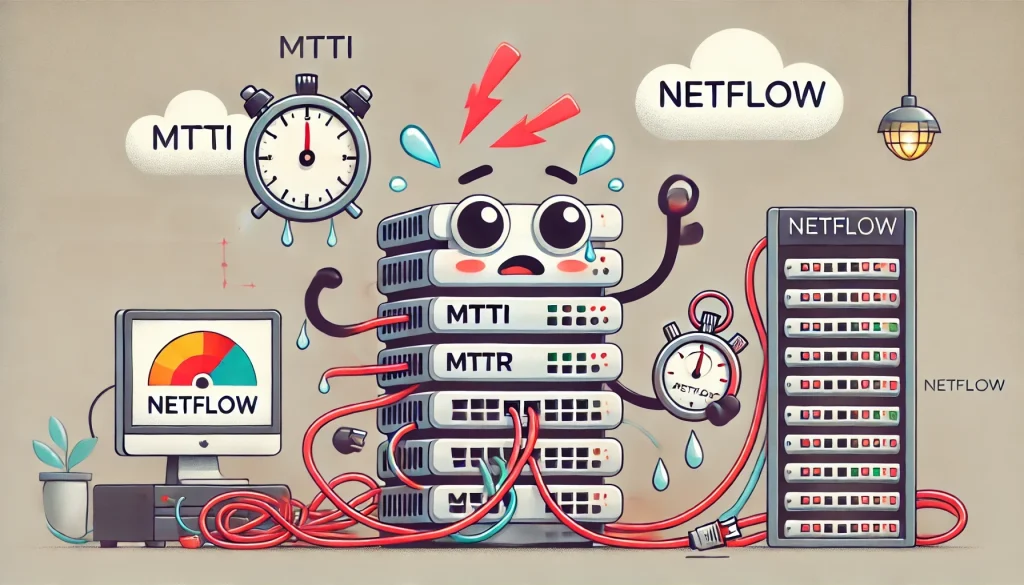In the fast-paced world of IT operations, time is money. Every minute a network issue goes unresolved translates to lost productivity, frustrated users, and potentially significant financial impact. Key metrics like Mean Time To Identify (MTTI) and Mean Time To Resolve (MTTR) are critical indicators of an IT team’s efficiency and directly influence business continuity. Read our previous article on the true cost of network downtime here.

Fortunately, NetFlow, a widely deployed network protocol, offers a powerful lens into network traffic, significantly accelerating both the identification and resolution of incidents.
NetFlow, present in most modern network infrastructure, captures a wealth of metadata about network communication flows. This includes details like source and destination IP addresses, port numbers, protocols, and traffic volume. By analyzing these flow records, IT teams gain unprecedented visibility into network behavior, enabling them to pinpoint the root cause of issues faster and restore services more quickly.
Conquering the Data Deluge: The Necessity of NetFlow Volume Reduction
The sheer volume of data generated by NetFlow, especially in large and active networks, can be overwhelming. Without proper management, this deluge of information can hinder rather than help in incident response. Sifting through millions of raw flow records to identify the source of a problem is akin to finding a needle in a haystack, drastically increasing MTTI. Therefore, implementing effective volume reduction techniques is crucial. Intelligent aggregation, which summarizes similar flows, and strategic filtering of less critical data, such as ephemeral client ports, are essential to make NetFlow data manageable and analysis-ready for rapid incident identification and resolution. To effectively leverage NetFlow for faster MTTI/MTTR, a well-planned data reduction strategy is paramount.
Adding Context for Clarity: The Power of NetFlow Enrichment
While raw NetFlow provides a foundational view of network traffic, its effectiveness in swiftly identifying and resolving issues is significantly enhanced through data enrichment. A stream of IP addresses and ports, while useful for basic troubleshooting, often lacks the crucial context needed for rapid diagnosis. Enriching NetFlow data transforms it into high-quality intelligence, making it invaluable for both human analysts and advanced tools like ML and AI. This enrichment involves correlating flow records with information such as user identity (through integration with directory services like Active Directory or Microsoft Entra ID), application details, device information, and even geographical location. For instance, knowing that a sudden spike in traffic originated from a specific user or device associated with a critical application immediately narrows down the potential problem area, drastically reducing MTTI. Without this context, deciphering “naked” IP addresses during an outage can be a time-consuming and frustrating process.
Seamless Integration: Amplifying Resolution Speed with Existing Systems
The true power of NetFlow in minimizing MTTI and MTTR is realized when it’s seamlessly integrated with existing IT ecosystems, particularly SIEM (Security Information and Event Management) and IT Ops systems. Organizations have already invested in these platforms for centralized monitoring and incident management. Feeding enriched NetFlow data into these systems enables powerful correlation with other machine data, such as server logs, application performance metrics, and security alerts. This holistic view provides a comprehensive understanding of the incident’s timeline and impact. For example, a network slowdown reported by users (logged in the IT Ops system) can be correlated with unusual traffic patterns to a specific server (identified by enriched NetFlow) and a spike in server CPU utilization (monitored by the IT Ops system), quickly pointing to the root cause. This integrated intelligence accelerates both the identification (MTTI) and the implementation of effective remediation strategies (MTTR), leveraging the existing infrastructure and workflows for faster resolution.
NetFlow in Action: Reducing MTTI and MTTR Scenarios
Here are concrete examples of how NetFlow helps reduce MTTI and MTTR:
- Rapid Identification of Network Congestion: A sudden increase in latency reported by multiple users can be quickly investigated by analyzing NetFlow data for top talkers or unusual traffic spikes on specific network segments, pinpointing the source of congestion within minutes (reduced MTTI). Once identified, targeted remediation steps like traffic shaping or rerouting can be implemented swiftly (reduced MTTR).
- Pinpointing Application Performance Issues: Users reporting slow performance with a specific application can be analyzed using NetFlow to identify network bottlenecks affecting traffic to the application servers, distinguishing network-related issues from application-specific problems, significantly reducing diagnostic time (reduced MTTI).
- Accelerated Security Incident Response: In the event of a security alert, enriched NetFlow data can quickly reveal the source and destination of malicious traffic, the affected users or devices, and the scope of the potential breach, dramatically accelerating threat identification and containment (reduced MTTI/MTTR). Correlating NetFlow with SIEM alerts provides a comprehensive timeline of the attack.
- Efficient Troubleshooting of Intermittent Issues: Intermittent network problems that are difficult to reproduce can be captured and analyzed using historical NetFlow data, providing insights into traffic patterns and potential triggers that might not be evident with real-time monitoring alone, leading to faster identification of the root cause (reduced MTTI).
Conclusion: Time is on Your Side with Intelligent NetFlow Utilization
In the high-stakes environment of modern IT operations, minimizing downtime and quickly resolving issues is paramount. By effectively managing the volume of NetFlow data, enriching it with crucial context, and seamlessly integrating it with existing IT ecosystems, organizations can transform this powerful protocol into a key asset for drastically reducing both MTTI and MTTR. Embracing an intelligent approach to NetFlow utilization empowers IT teams to proactively identify, rapidly diagnose, and swiftly resolve network incidents, ultimately ensuring business continuity, maximizing productivity, and safeguarding the bottom line.
